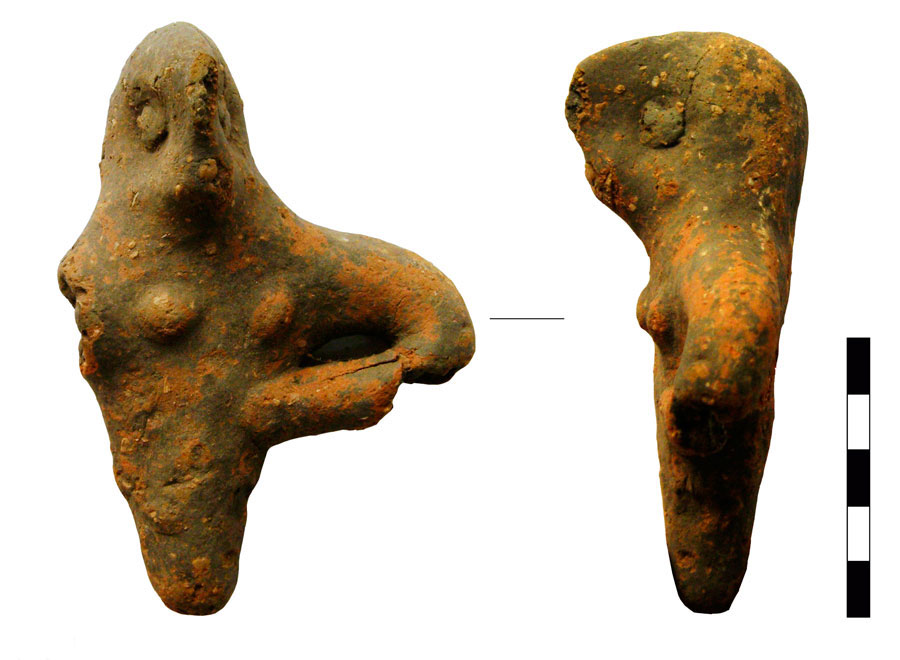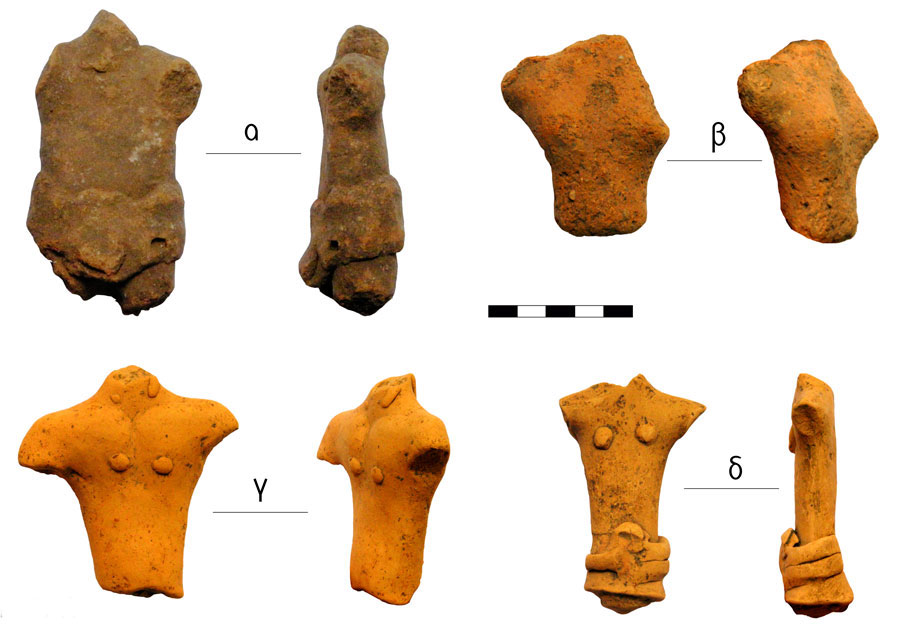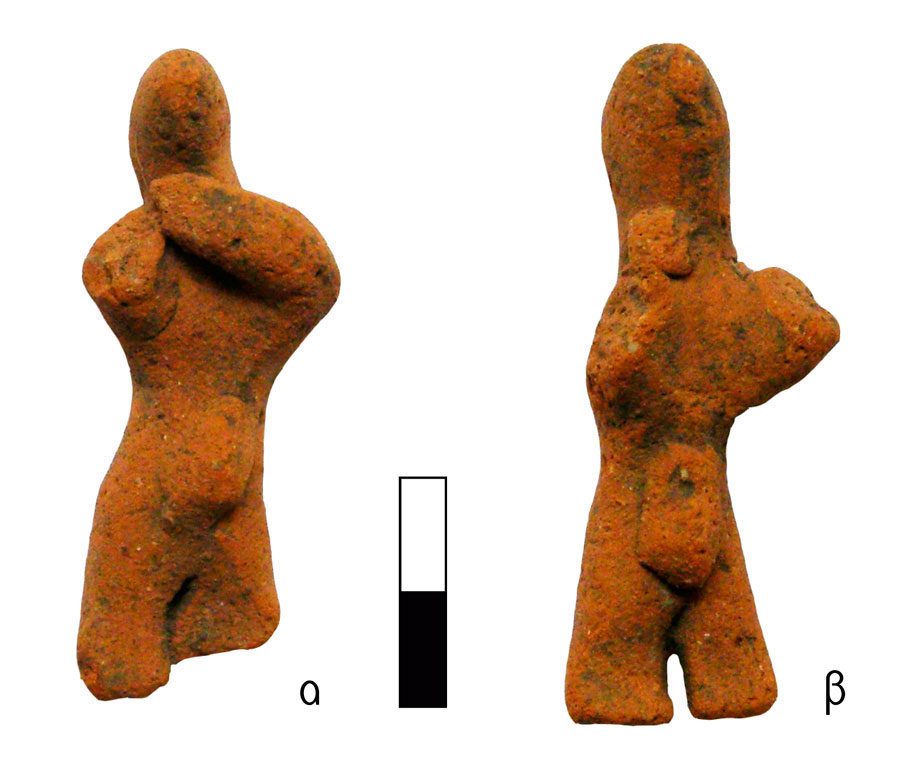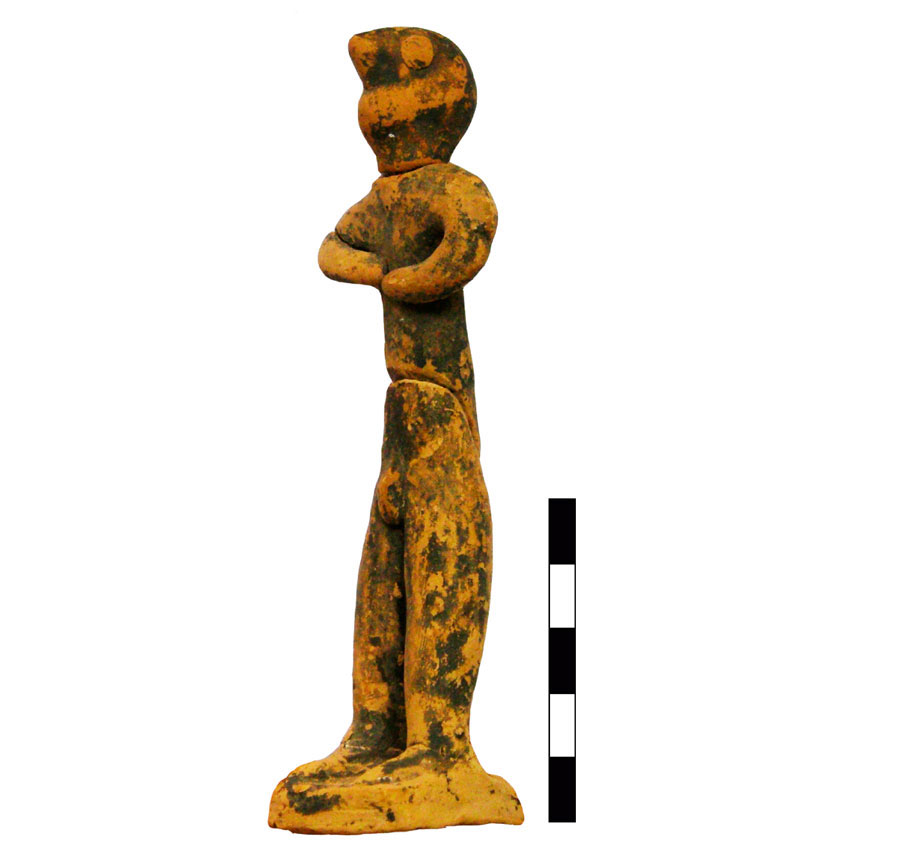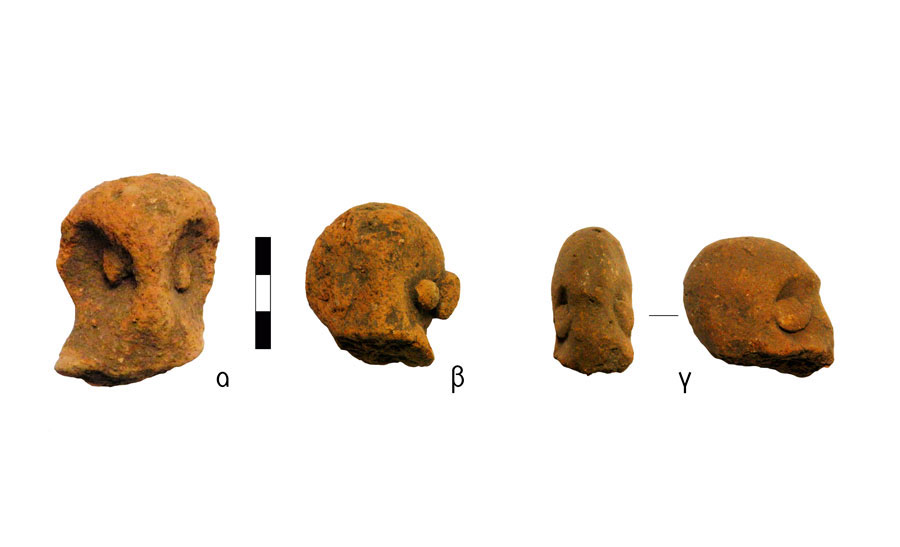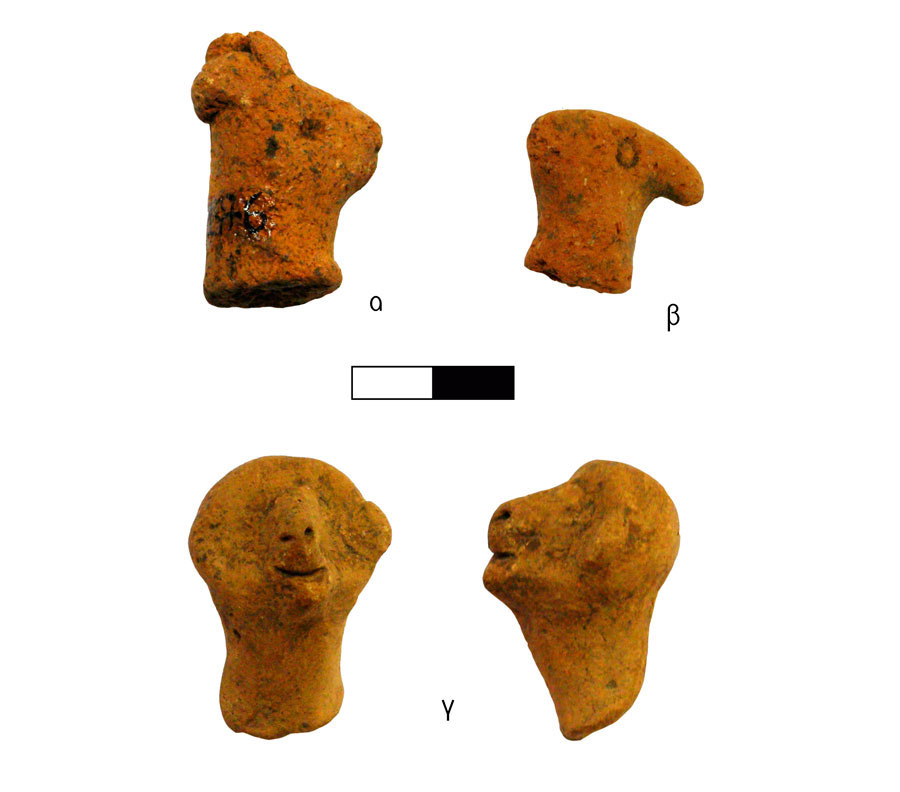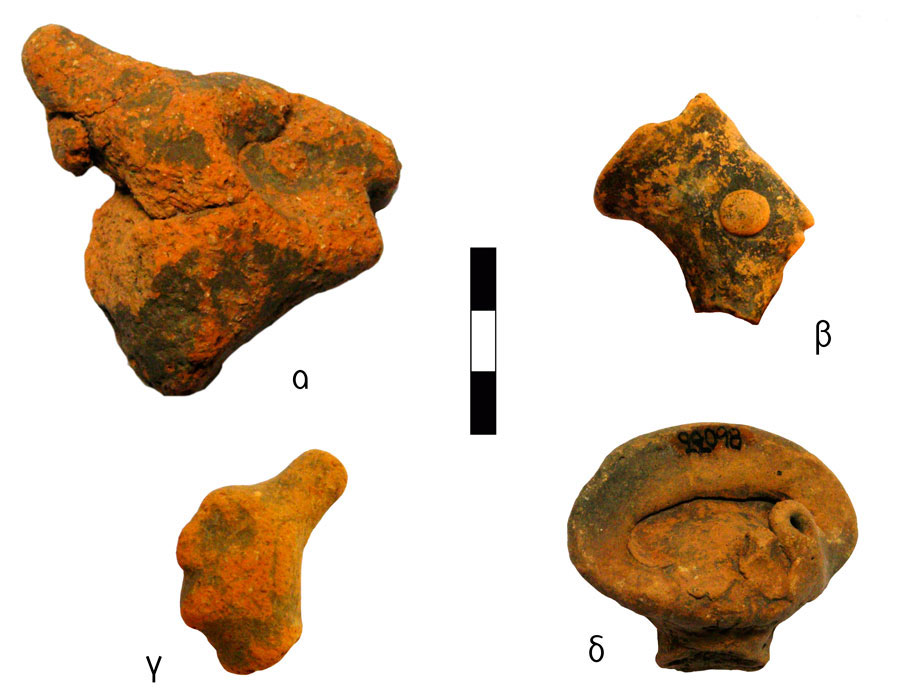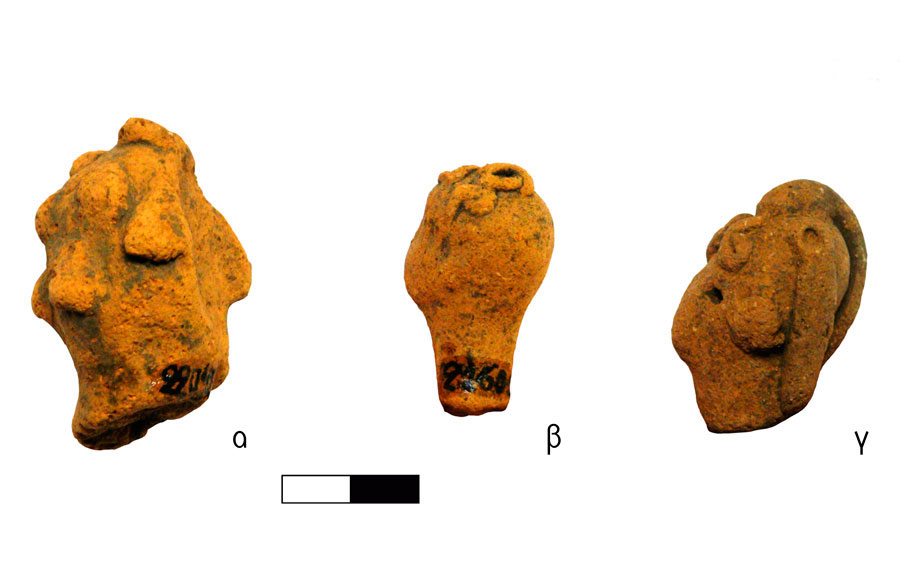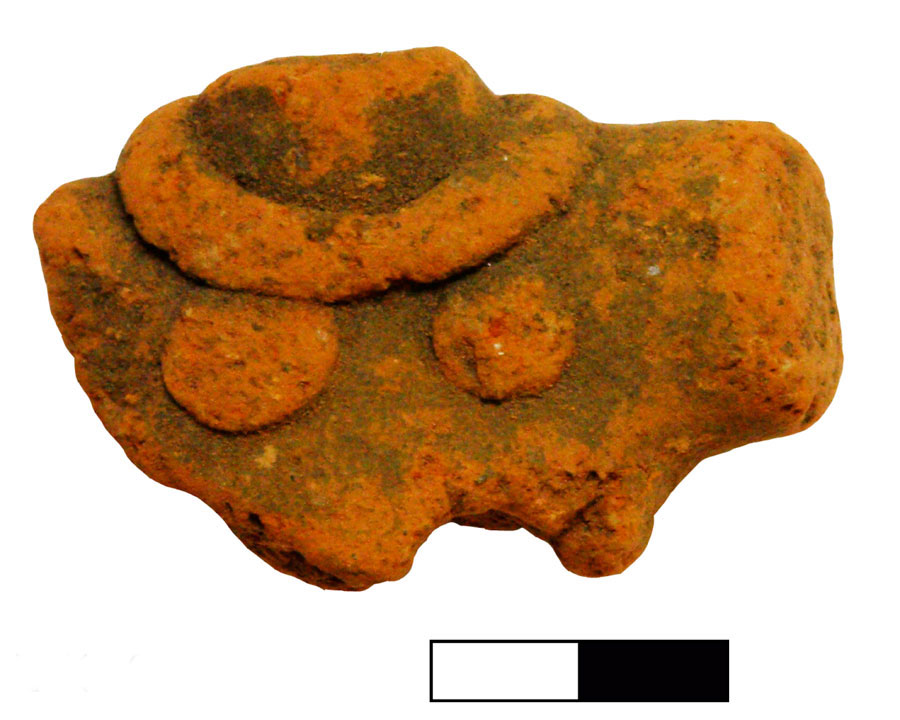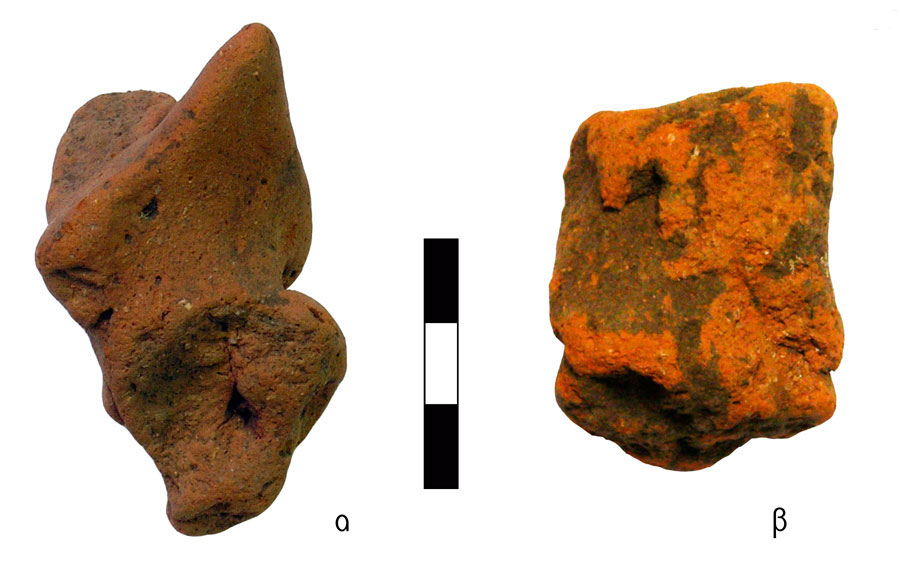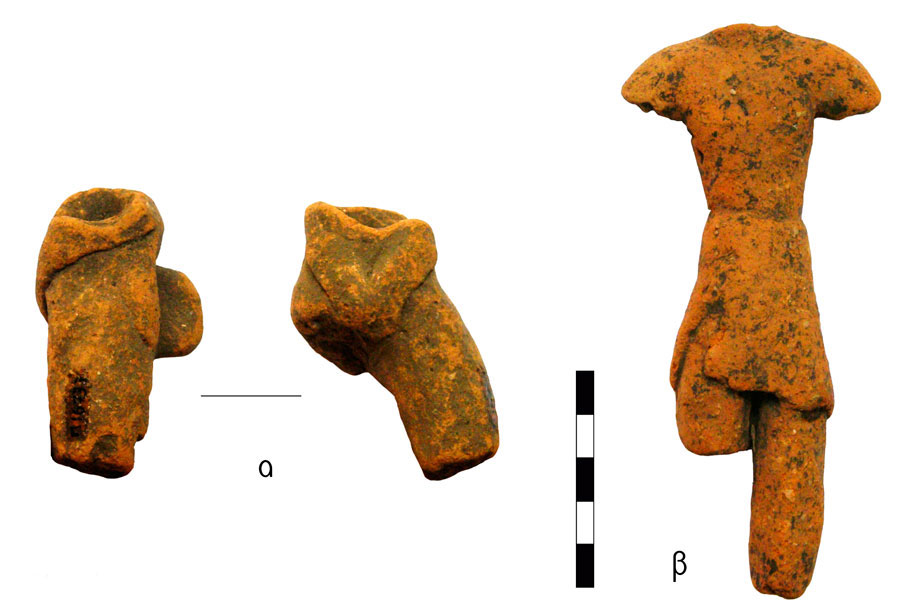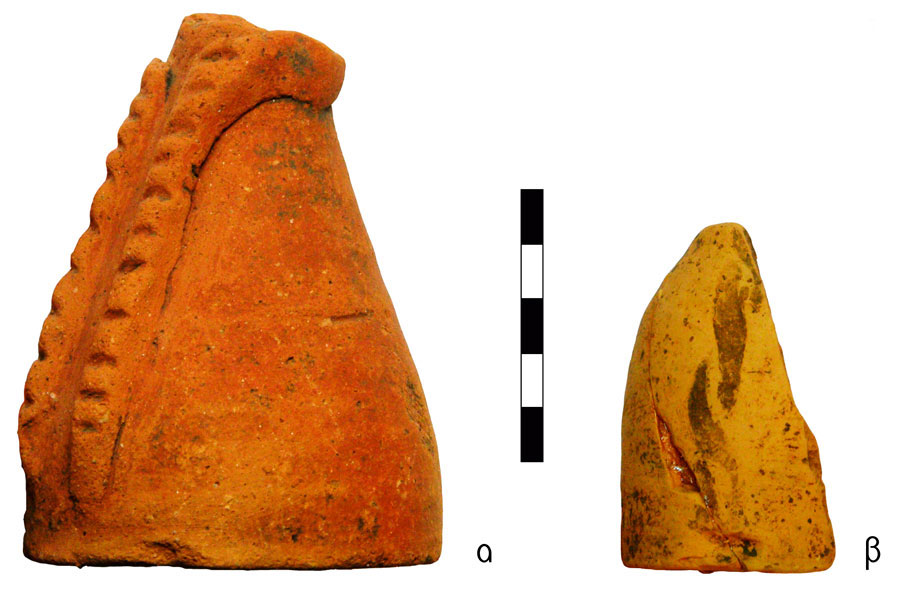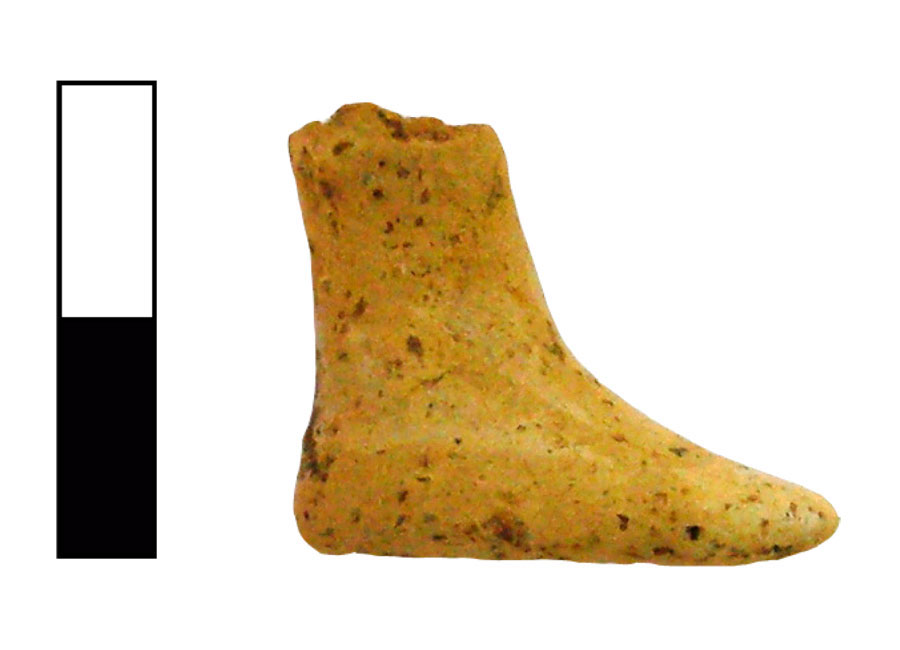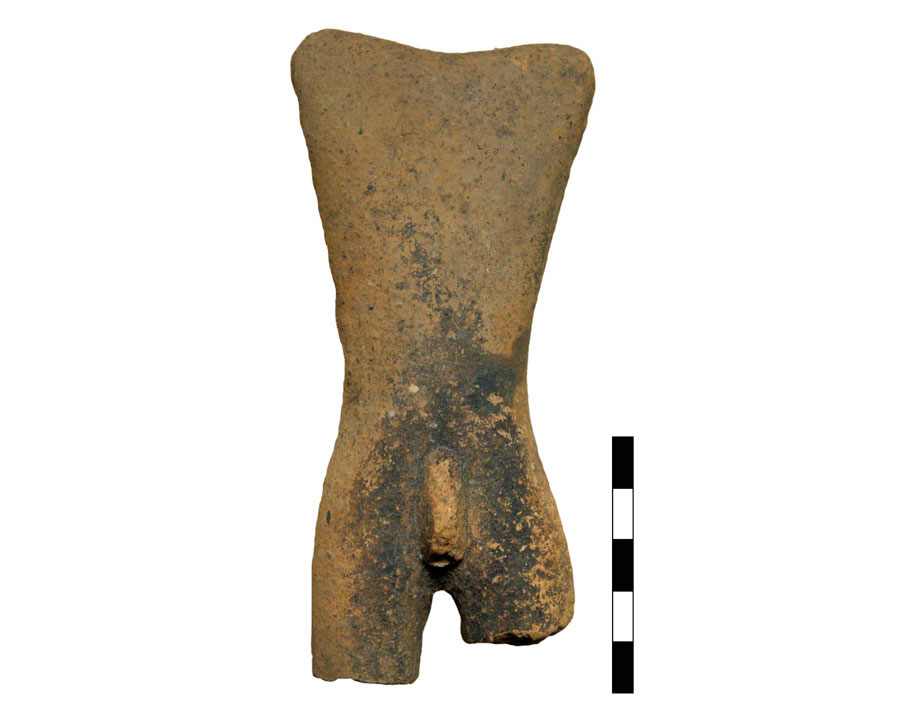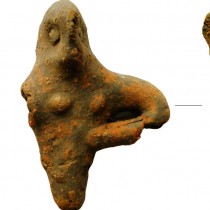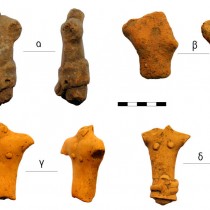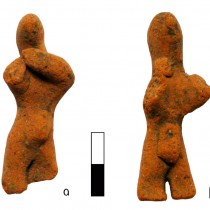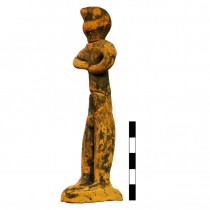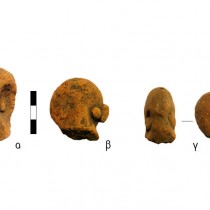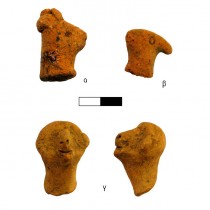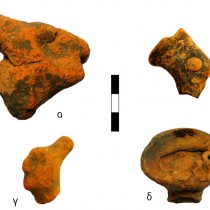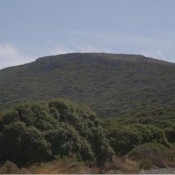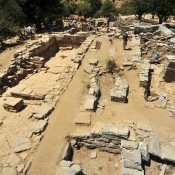As one of the most representative types of assemblage found at every Minoan mountain-edge sanctuary, an impressive number of clay human figurines was discovered on the peak of Agio Pneuma on Vrysinas. These figurines, together with the even larger mass of figurines representing animals, mostly bovids, place Vrysinas among the most important archaeological sites with regard to image-making in clay. For practical reasons, the fragments of human figurines were separated from the vast mass of other pictorial fragments of the assemblage (K. Davaras excavations 1972-1973), so that they could be studied effectively. The systematic study of this group of human figurines forms the subject of my PhD dissertation in the Department of History and Archaeology of the University of Crete, carried out with the financial assistance of the Panayotis and Effie Michelis Foundation.
The material is extremely fragmentary. The unique local environmental conditions at the site and the successive disturbances of the thin fills of the mountain peak are responsible for the state in which the fragile clay figurines were found. Their mutilation and quantity greatly undermined their determinative archaeological investigation and systematic study. The process of separating them out from the huge number of clay pieces resulting from the 1972-73 excavations produced a total of 2,785 fragments originally identified as belonging to human figurines. According to the statistical analyses, the 695 heads counted are combined with 873 records of upper torsos, demonstrating the dynamics of the plethora of human figurines in the specific sample.
The attempt to group the fragments on the basis of stylistic features – i.e. the volume of individual pieces, the outlines, the proportions of body members – and the identification of practices used for the technical and aesthetic representation of the human body, was one of the greatest challenges facing the study of the whole assemblage. In this attempt, multitudinous manifestations of an inexhaustible expressiveness of plastic art in clay came to light, gradually highlighting aspects of Minoan ceramic narrativity in the rendition of the human form, which extends in a range of variations from the early 2nd to the early 1st millennium BC. Obviously, we assume that there would have been lengthy gaps in this production. However, the survivals and revivals of narrative expressiveness in the hand-moulding of the human form in clay display, variations aside, an impressive cohesion and completeness. The basic axes of the narrative language of “additive” clay-shaping (rather than the “abstractive” methods of sculpture), inevitably brings out the makers’ perceptions and image of the human figure, while simultaneously displaying their views on the position of human beings in the specific cultural context.
In three dimensions
The rendition of the human form in three dimensions, especially in malleable clay, reveals both techniques and aesthetic considerations, parameters that preoccupy the potter in his attempt to achieve the fullness of the representation. The perception that two dimensions predominate in the formation of the separate parts of the human body is highlighted by a small group of figurines (fig. 1). The triangular torso, flattened and without the addition of clay to bulk it out, contrasts with the head, which has been produced by strong pressure stressing the features of the profile. The figurines in this group, which belong to the early potting traditions, reflect corresponding perceptions visible in the Protopalatial two-dimensional anthropomorphic representations, the seals: the frontal triangular torso is combined with a rounded head in profile.
The level of development of the volumes echoes basic characteristics of the perception of the form of the human body. At the same time, it highlights the fluctuations of stylistic processes in the multitude of pottery traditions from Vrysinas. A comparison of some samples shows the level of bulking of the upper torsos. The torso of the male figurine (fig. 2a), which is placed among the early pottery traditions of the group, presents a rigid outline, while it is also heavily flattened. The naturalistic bulking of the female torso, on the other hand (fig. 2b), demonstrates the dynamics of Minoan plastic art in clay. This sample is dated to the early Neopalatial period, a particularly wealthy era for the sanctuary. A similar, though more stylized, bulking is seen in the male torso (fig. 2c) on which the chest muscles stand out, while the nipples are represented by small applied discs. Finally, the elongated, plank-shaped female torso (fig. 2d) demonstrates the evolutionary processes of late pottery traditions at Vrysinas.
The scale
The clay figurines found on Vrysinas are not all of the same size. A rough distinction may be made between the microscopic figurines measuring 4 to 6 cm high, and the sizeable figurines averaging 12 to 15 cm. Obviously the reduction of the human form to the “miniature scale of representation” is connected to the functionality of each figurine, and the process inevitably results in a dilution of their narrative adequacy. Clay figurines, regardless of size, that are detached from their contexts, i.e. their narrative pottery environment, and figurines of all kinds that, still set on their base, potentially retain their “individuality” and autonomy within the pottery assemblage of human forms, are studied together, although their functional nuances – their utilitarian values – appear to differ significantly.
The example of two microscopic male figurines, belonging to a common multi-figure model, gives us a characteristic picture of “miniature narrative” in the anthropomorphic pottery of Vrysinas (fig. 3). The fabric, the morphological elements such as the applied codpiece, and the distinctive gesture with the left hand touching the right side of the neck while the other is folded towards the chest, the pointed oval head, and the proportions and outlines of the body, are all identical. Moreover, the separate impressions on their short lower limbs and the relative curve on the back of the legs permit us to hypothesise that they were attached to a vertical element of the “scenery”, i.e. the base, of the multi-figure model on which they were set. On the basis of other corresponding examples, the figures were presumably arranged in a circle.
The size of the intact figurine in figure 4 corresponds to the average size of the larger figurines in the assemblage. Its functional autonomy is evidenced by the fact that it stands on a square base. However, how far the traditionally recognised “worshiper” of the Minoan peak sanctuaries was a narratively autonomous figurine, among the multitude of other human figures, has been called into question. Despite the particularly rough rendition of the proportions of the body and its individual features, which form part of this particular stylistic tradition, the figurine is complete or even over-abundant in its details. These details are not rendered with plastic elements but by the use of colour, traces of which are preserved on the whole body. The comfortable layout of the various characteristics highlights focuses and suppressions different to those observed on the microscopic figurines.
Anthropomorphism
Apart from the reductions of scale and three-dimensional representation of any object, the moulding of the human figure itself involves the most complex parameters. The practice of forming a small image of the self “in one’s own image”, especially in three dimensions, presents the potter with a multitude of difficulties regarding the clarity of the rendition. Independent of his technical skills and the conventions of the art he practices, the maker’s efforts potentially echo deeper cultural values to do with the human form, of which he is the conveyor. His intentions in each case reveal the codes or conventions of anthropomorphism, as they evolve in every cultural phase of the Minoan civilisation. If there were indeed many centres of production of the figurines, as the Vrysinas assemblage indicates, whether the makers were also the users of the figurines or whether they were specialised craftsmen, it is worth searching for possible synchronicities that might arise from the multitude of pottery traditions of the site.
The head, and especially the rendition of the facial features, indicates precisely this variety. In the examples in figure 5, the three heads, derived from the early pottery traditions of the sanctuary, not only demonstrate alternative means of portraying these characteristics, but also reveal the particularities of the potter’s art at the largest known peak sanctuary in West Crete, compared to corresponding sites in the central and eastern part of the island. But apart from the abstractional conventions of each style, the faces also reveal an underlying hybridism, or even similarities to zoomorphic characteristics – or, rather, to characteristics of mixed human-animal beings.
The plethora of humanoid beings with bird or animal heads depicted both in seal-carving and in other arts of the Protopalatial and Neopalatial periods, bears witness to the incorporation of these beings into the imaginary world of Minoan culture. The archaeologists who attempted to make a selection from the huge mass of fragments of animal and human figurines discovered at the Vrysinas peak sanctuary, were faced with the task of sorting heads that could not be placed with the animals but were by no means definitely human. Thus, among the fragments of human figurines were found griffins’ and birds’ heads (fig. 6a, b), and other monstrous heads that further highlighted the questions surrounding the underlying hybridism of the human heads. Moreover, the detailed observation and description of the fragments led to the identification of an ape’s head, the first known clay figurine of an ape to be discovered at a mountain-edge site (fig. 6c). The skilful naturalistic rendition of the various features of the muzzle and the rest of the head made the identification certain despite the original doubts.
“Distinctive features” of the body: the human body and its cultural elements
The clothing that covers the human body and the accessories of all kinds that accompany it, do not just meet practical or decorative needs but also bestow cultural meaning and social signification on it. It has been stressed that the attributes borne on the body “lend distinction” to the forms of the clay figurines from Minoan peak sanctuaries, raising the question of image and display among contemporary people. The Vrysinas figurines do not present a variety of elements worn on the body, but they are displayed in a wide range of ways. Head coverings predominantly comprise the pointed cap (fig. 7a), and many variations on the conical cap (fig. 7b). The cap is sometimes confused with a pointed top of the head, presumably indicating a topknot (krobylos) (fig. 7c), while in rare cases the hair and hat are mingled together (fig. 8d), a feature observed in figurines from other peak sanctuaries.
Hairstyles with locks of hair present a wider variety. The size and form of the hair is particularly significant in the identification of the figure, even indicating the person’s age. Vrysinas has produced a range of styles, from shaven heads with one or more locks of hair (fig. 8a), or a clump of short curls on the top of the head (fig. 8b), to particularly complicated hairstyles with symmetrically arranged locks (fig. 8c).
The delible paint and the flaking of the fine crust of the colours do not permit an in-depth investigation of the quantity of jewellery that would probably have been painted on the figurines. Of the very few pieces of jewellery rendered in plastic relief, we note the earrings with small applied discs, which are sometimes confused with the auricles, and a very few examples of necklaces (fig. 9).
The female bodice (fig. 10a– rear view) – with an impressively high peak at the back of the neck which is obviously stressed particularly – is one of the few indications of dress to be safely dated to the Protopalatial period. Dating of handmade clay figurines on the basis of clothing styles is rarely accurate, not only because Minoan dress, both male and female, presents morphological characteristics that remain unchanged throughout the Middle and Late Bronze Age, but also because any variations in details of dress evolution are hard to recognise in the moulded features of such tiny figures. The male garment covering the upper body (fig. 10b – rear view), also seen on figurines from other sites (Malevisi), is probably also Protopalatial in date.
The Minoan garment covering the lower body is found in a wealth of moulded examples from Vrysinas, which permit a basic re-evaluation of its form and the way it was worn. The codpiece, consisting of a single long piece of cloth wrapped around both hips, forming an acute angle at the back (fig. 11a), and the rectangular loincloth wrapped around the waist and falling like a short skirt, are depicted on many figurines in a wide range of variations (fig. 11b).
The wheelmade skirts of the female figurines are accompanied by the applied moulded band of the belt (fig. 12a), tied round the waist in various ways. Even the way in which the two ends of the belt fall down the front of the skirt presents innumerable variations, such as the rendition of the twisted material by deep wavy grooves (fig. 12b). The rich narrative of the female belt is not only ornamental but may also be a feature of the identity of each female figure. As we know, the belt on the female body contains a plethora of symbolisms with regard to her social inclusion and general status.
Finally, in a few cases, plastically-rendered male footwear can be discerned. Some samples even retain faint traces of colour indicating the straps (black on white) of Minoan sandals (fig. 13); rare three-dimensional renditions of these only survive on fragments of ivory figurines.
The rhetoric of the body: focuses and suppressions
A small but equally significant number of figurines represent individual parts of the human body. In this case, too, the largest peak sanctuary of West Crete presents novel sections of the human body compared to the corresponding examples from other peak sanctuaries of Central and East Crete (fig. 14). In these strange figurines, the techniques used to focus on and highlight specific body parts are achieved by splitting up the human form. The many different interpretations of these figurines turn on the meaning of the maker’s focus on these particular members. In any case, however, these representations, taken as a whole, indicate the familiarity of the bearers of Minoan culture with the fragmentary human body.
But the narrativity of the anthropomorphic pottery of Vrysinas does not end here. The support of a human figurine, its incorporation into the context of the other pictorial themes, and even its wider setting among the multitude of disparate objects comprising the rich assemblages that characterise the site we call a “peak sanctuary”, are expressions of a narrative whose fragments we are called upon to piece together. Next to the thousands of representations of figures in seal-carving, which preserve the contexts of human behaviour, and the impressive, sometimes life-sized depictions of the wall-paintings, which highlight a wealth of detail, fragmentary ceramic figurines, as an intermediate link in the representation of Minoan man, have not yet said their final word…
Dimitris Sfakianakis
Doctoral Candidate of the University of Crete
